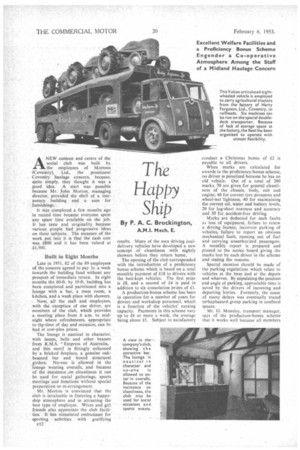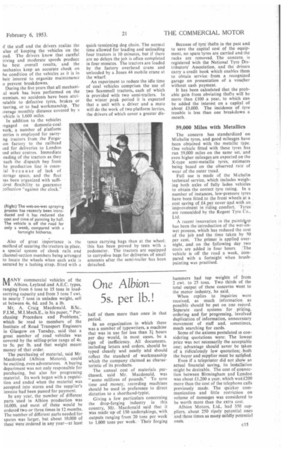The
Page 50

Page 53

If you've noticed an error in this article please click here to report it so we can fix it.
Happy Ship
By P. A. C. Brockington,
A.M.I. Mech. E.
ANEW canteen and centre of the social club was built by the employees of Mortons (Coventry), Ltd., the prominent Coventry haulage concern, because, quite simply, they thought it was a good idea. A start was possible because Mr. John Morton, managing director, provided the shell of a temporary building and a sum for
furnishings. .
It was completed a few months ago in record time because everyone spent any spare time available on the job. It has taste and originality because various people had progressive ideas on these subjects. The measure of the work put into it is that the cash cost was £800 and it has been valued at £1,500.
Built in Eight Months
Late in 1951, 82 of the 89 employees of the concern agreed to pay Is. a week towards the building fund without any prospect of immediate return. In eight months the 60-ft. by 19-ft. building has been completed and partitioned into a lounge with a bar, a mess room, a kitchen, and a wash place with showers.
Now, all the staff and employees, with the exception of one driver, are members of the club, which provides a meeting place from 6 a.m. to midnight where refreshments, appropriate to thentime of day and occasion, can be had at cost-plus prices.
The lounge is nautical in character, with lamps, bells and other brasses from R.M.S. "Empress of Australia, ' and this motif is fittingly enhanced by a bricked fireplace, a genuine oakbeamed bar and boxed structural girders. No-one is allowed in the lounge wearing overalls, and because of the insistence ..on cleanliness it can be used for social gatherings, sports meetings and functions without special preparation or re-arrangement.
Mr. Morton is convinced that the club is invaluable in fostering a happyship atmosphere and in attracting the best type of employee. Wives and girl friends also appreciate the club facilities. It has stimulated enthusiasm for sporting activities with gratifying c12 results. Many of the men driving coaldelivery vehicles have developed a new concept of cleanliness with nightly showers before they return home.
The opening of the club corresponded with the introduction of a proficiency bonus scheme which is based on a total monthly payment of £18 to drivers with the best-kept vehicles. The first prize is £8, and a second of £4 is paid in addition to six consolation prizes of £1.
A production-bonus scheme has been in operation for a number of years for drivers and workshop personnel, which is a function of the vehicles' earning capacity. Payments in this scheme vary up to £6 or more a week, the average being about £1. Subject to satisfactory conduct a Christmas bonus of £2 is payable to all drivers.
When marks are calculated for awards in the proficiency-bonus scheme, no driver is penalized because he has an old vehicle. Out of a total of 200 marks, 70 are given for general cleanliness of the chassis, body, cab and engine, 40 for correct tyre pressures and wheel-nut tightness, 40 for maintaining the correct oil, water and battery levels, 20 for log-sheet neatness and accuracy and 30 for accident-free driving.
Marks are deducted for such faults as loss of equipment, failure to renew a driving licence, incorrect parking of vehicles, failure to report an obvious mechanical fault, running out of fuel and carrying unauthorized passengers. A monthly report is prepared and pinned to the notice board giving the marks lost by each driver in the scheme and stating the reasons.
Special mention should be made of the parking regulations which relate to vehicles at the base and at the depots and wharves. By stipulating the position and angle of parking, appreciable time is saved by the drivers of incoming and departing lorries. Formerly, the cause of many delays was eventually traced toahapha2ard group parking in confined spaces.
Mr. G. Mousley, transport manager, says of the production-bonus scheme that it works well because all members
if the staff and the drivers realize the aloe of keeping the vehicles on the Dad. The drivers know that careful lriving and moderate speeds produce he best overall results, and the nechanics keep an accurate check on he condition of the vehicles as it is in heir interest to organize maintenance o prevent breakdowns. During the five years that all mechanial work has been performed on the treatises, no accidents have been attrimtable to defective tyres, brakes or teering, or to bad workmanship. The Lverage monthly distance covered by a 'chicle is 1,600 miles.
In addition to the vehicles .ngaged on domestic-coal. vork, a number of platform orries is employed for carryng tractors from the Ferguion factory to the railhead end for deliveries to London end other centres. Immediate oading of the tractors as they each the dispatch bay from he production line is cssenial because of lack of Ltorage space, and the fleet as been organized with suffi:lent flexibility to guarantee :ollection "against the clock."
Also of great importance is the method of securing the tractors in place, a special system of chock rails and :hannel-section members being arranged to locate the wheels when each axle is secured by a lashing strap, fitted with a
quick-tensioning dog chain. The normal time allowed for loading and unloading four tractors is 10 minutes, but if there are no delays the job is often completed in four minutes. The tractors are loaded by the factory overhead crane and unloaded by a Jones 44 mobile crane at the wharf.
An experiment to reduce the idle time of coal vehicles comprises the use of two Scammell tractors., each of which is provided with two semi-trailers. In the winter peak period it is expected that a unit with a driver and a mate will do the work of two platform lorries, the drivers of which cover a greater dis tance carrying bags than at the wheel; this has been proved by tests with a pedometer. The tractors are equipped to carrysfive bags for deliveries of small amounts after the semi-trailer has been detached. Because of tyre thefts in the past and to save the capital cost of the equipment, no spare lyres are carried and the racks are removed. The concern is registered With the National Tyre Distributors' Association. and the drivers carry a credit book which enables them to obtain service from a recognized garage on presentation of a voucher without cash payment. It has been calculated that the probable gain from obviating thefts will be more than £100 a year, to which can be added the interest on a capital of about £3,000. The incidence of tyre trouble is less than one breakdown a month.
59,000 Miles with Metallics The concern has standardized on Michelin tyres, and good mileages have been obtained with the metallic type. One vehicle fitted with these tyres has run 59,000 miles on the same set, • and even higher mileages are expected on the X-type semi-metallic tyres, estimates being based on the observed rate of wear of the outer tread.
Full use is made of the Michelin technical service, which includes weighing both axles of fully laden vehicles to obtain the correct tyre rating. In a number of instances, low-pressure tyres have been fitted to the front wheels at a cost saving of £4 per cover and with an improvelnent in riding comfort. 'Tyres are remoulded by the Regent Tyre Co., Ltd.
A recent innovation in the paintslipp has been the introduction of the wet-onwet process, which has reduced the cost of the job and the time taken by 50 per cent. The primer is applied overnight, and on the following day two coats are added in four hours. The vehicle is off the road a week, compared with a fortnight when brushpainting was practised.




























































































